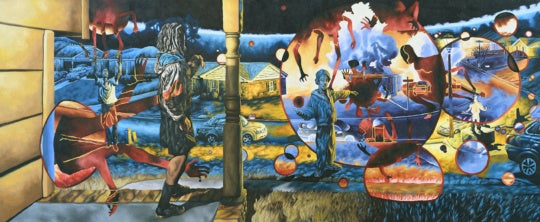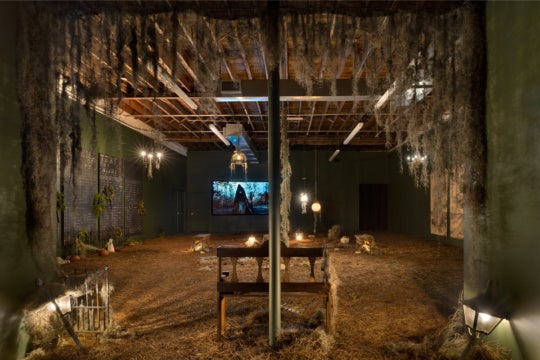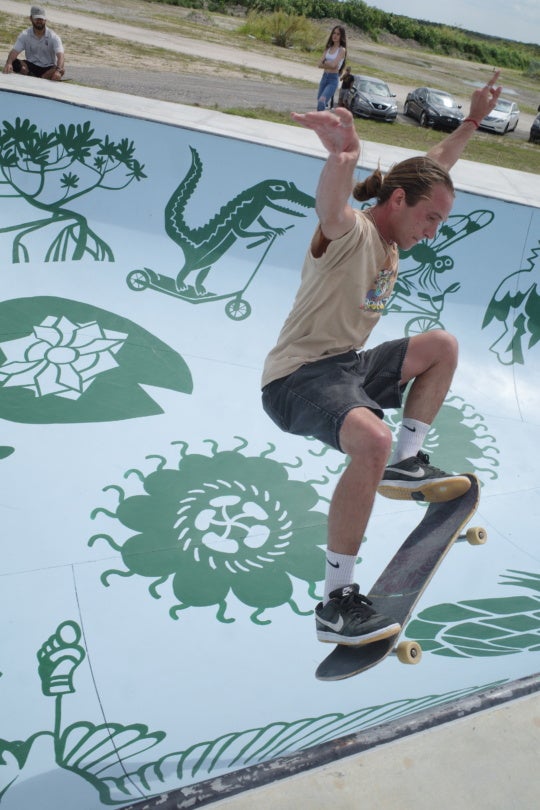
Photography has the capacity to store history. The current exhibition at Jackson Fine Art, featuring Mona Kuhn’s Bordeaux and William Christenberry’s Working From Memory, showcases two photographers who work to store and create history. Kuhn’s focus is on portraits of friends who spend the summer with her at her retreat home in Bordeaux, while Christenberry photographs the changing landscape and features of his home over time. Although their subjects are worlds apart, both in content and style, each photographer creates a personal history by documenting either surroundings or close acquaintances that have impacted their memories. These homages to people and place exploit the power of photography to “capture” and freeze those moments which would normally pass us by or are too fleeting to grasp with the naked eye.

Whether digital or chemical (film), photography is imbued with a special power no other medium has; it freezes time, taking individual slices of what is otherwise experienced as a constant stream of light and opening them up to investigation and scrutiny. During the dawn of photography, time played a crucial role in the photographic process, taking hours to make an exposure. Early portrait photographers would construct apparatuses to constrict the movement of the subject, so much that sometimes her or his head would be bolted in place to prevent any motion or blur in the face. As technology progressed, the capacity to freeze motion became a major obsession for some photographers. Eadweard Muybridge studied motion intensely; his most famous study, The Horse in Motion, 1878, was a technical marvel of the time. It clearly depicted a horse at full gallop with its four feet off the ground, an idea that had been discussed and debated but never settled until Muybridge photographed the phenomenon.
This obsession with motion and time has since faded as newer technologies have become capable of many more spectacular feats dealing with motion. Consequently, the novelty has worn off, but the implications continue within contemporary photography, no matter what the subject. Photojournalism exploits this former novelty by freezing an intense moment where a gesture or facial expression participates in telling a larger story that writing alone could not relate; consider Dorothea Lange’s Migrant Mother, 1936, Robert Capa’s photographs of World War II, or Eddie Adams’s Murder of a Vietcong by Saigon Police Chief, 1968. Some photographers have used this idea of time to amazing effects, such as Hiroshi Sugimoto’s Theaters, where he compresses the time and light of one movie into a single photograph. Kuhn and Christenberry both confront time and memory in ways that may seem obscure at first, but which come alive with the curation of the exhibition.

Christenberry is featured in the front half of the gallery, while Kuhn’s work is located in Jackson’s much more secluded backroom. This differentiation of space within the gallery helps impact how the viewer ultimately receives the work. As the viewer walks into Jackson Fine Art, they are met with Chrstenberry’s work, which comprises selections from his book Working From Memory. While there are a number of large, beautifully printed images from the book, what I believe stood out more, were the grids of photographs comprising decades of individual shots of the same landscape: 5 Cent Sign, Demopolis, Green Warehouse, and Red Building in Forest. These plainly titled series depict not only the passage of time, but also how a photographer can impact the place they are trying to capture. Placed next to these grids are anecdotes that can be found in the book. The stories explain how Christenberry’s photographs have altered the landscape he has been trying to preserve: the 5 cent sign will never be painted over because there is a famous photograph of it (Christenberry’s own); after his death, the owner of the green warehouse left specific instructions that the building, if repainted, remain that shade of green. Finally in Red Building in the Forest, an unsightly storage shed was placed in front of Christenberry’s subject, which was moved at the behest of locals to preserve the picturesque view Christenberry had codified in their minds.
These stories are insightful, and show at once the power of the photograph to capture and preserve a historical document while at the same time providing evidence that once a photograph of an object has been made, it forever burns an imprint in one’s mind of what that thing should look like. As Susan Sontag remarks in her book On Photography, “All photographs are memnto mori.” In each of these grids of photographs, the progression of time is plain to see: things fade or come to be overgrown; there are clear marks of decay, signaling death’s inevitable encroachment on the object.

But in Christenberry’s work, there seems to be an active participation in death and memory. His photographs have created a vision of particular landscapes in the South and now communities—those that have been photographed by Christenberry—actively work to reproduce and preserve the memory that Christenberry’s photographs have captured. In order to ensure that things remain the way they look in the photograph, the community removes features that interfere with Christenberry’s idyllic images, or simply preserve the scene or landscape so that it forever reflects in real life what it does in the photograph. These unintentional consequences of Christenberry’s decades-long photographic project reveals photography’s connection to memory and history. In this case, Christenberry originally sought to preserve the changing landscape of the South and by doing so, created a “nostalgic” image of himself: his story becomes the story as his photographs act on the collective image of the South. Christenberry has remarked that he thinks “oftentimes art can make an outsider look back on something he has never been a part of and make him feel like he has always been a part of it.”
After passing through the Christenberry portion of the exhibition, you come to Mona Kuhn’s Bordeauxseries. This collection is mainly composed of portraits, but a few black and white landscapes have been added in as well. Although largely known for her portraits, the inclusion of the landscapes help add a certain intimate atmosphere to the gallery space. Whereas Christenberry’s project documents the changes within a region of geography (the South), Kuhn sets out to preserve her memory of a special place and time associated with her summer retreat.

Bordeaux is as much about the people as it is about the place. According to Kuhn, “the photographs are similar to bread crumbs that I throw on the path to help me memorize a way back to this place and these emotions.” The installation of the portraits with the landscapes in the smaller space helps the viewer feel included within that place and its corresponding emotions.
The portraits are nudes, but the fact that they are nude seems beside the point. These photographs do not appear to be about the human form, but about a vulnerability that Kuhn’s summer house evokes in the subject. This vulnerability is not just in the form of nudity, but in the expressions, the carefree posing, and the beautiful quality of the light. Additionally, Kuhn’s portraits are all taken in one location, a sparse room with a reddish old cloth curtain for a backdrop with the occasional chair as a prop, nothing else. The limited details force the viewer to focus on the subject: on the eyes, the nose, the hair, to almost see past their nudity. They are by no means “naked.” Kuhn’s subjects show an almost hyper awareness of the camera by appearing to disregard it completely. There is a level of comfort in her subjects that can only be achieved if the subject is a close friend of the photographer.
These are not just portraits that celebrate the carefree and beautiful days of youth à la Ryan McGinley; nor are they about the human form as in Edward Weston’s nude of Tina Modotti. It is about how that place, which Kuhn returns to summer after summer, creates a bond between photographer and subject. For Kuhn, the best way to preserve that memory is to photograph it.
Hung next to Kuhn’s color portraits are her black and white photographs of Bordeaux’s landscape. These images are not as stunning as the former, but when standing amidst both within the smaller space of Jackson Fine Art’s back gallery, the story, the time, and the place all seem to meld together. In that room, the viewer is transported to a summer where storms roll in and drench the landscape, in a house with no power and very few modern conveniences—a place where you could let your apprehensions fade.
Both of these bodies of work use photography to play with memory and history. Christenberry acts to record history with his camera but in turn affects that which he is documenting by creating a narrative for the place itself. Kuhn’s work, on the other hand, attempts to capture a sense of time and place through portraits, hoping to preserve the impact that her friends have had on her. Both are personal projects exposing a little about the photographer, sometimes more so than what is actually photographed. Regardless of how you view the work, Jackson Fine Art should be applauded for pulling off an installation like this. With prior knowledge of these two photographers, I was unsure of a connecting thread or how they would play out in the space together. Upon walking into the gallery, however, it immediately becomes apparent; you have not only walked into a gallery, but into the stories of each photographer.
Mona Kuhn’s Bordeaux and William Christenberry’s Working From Memory will be up at Jackson Fine Art through Friday, June 8, 2012.




